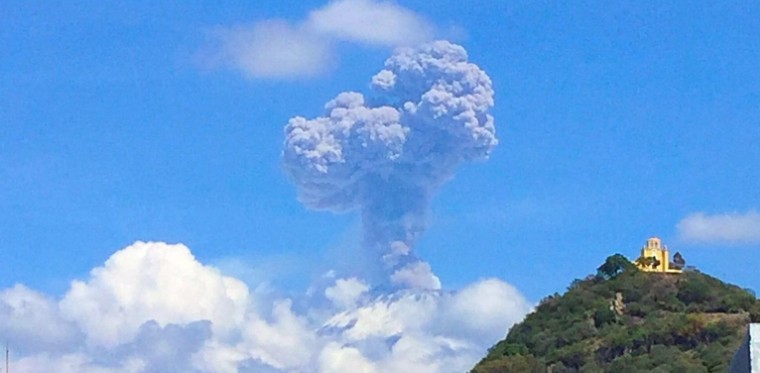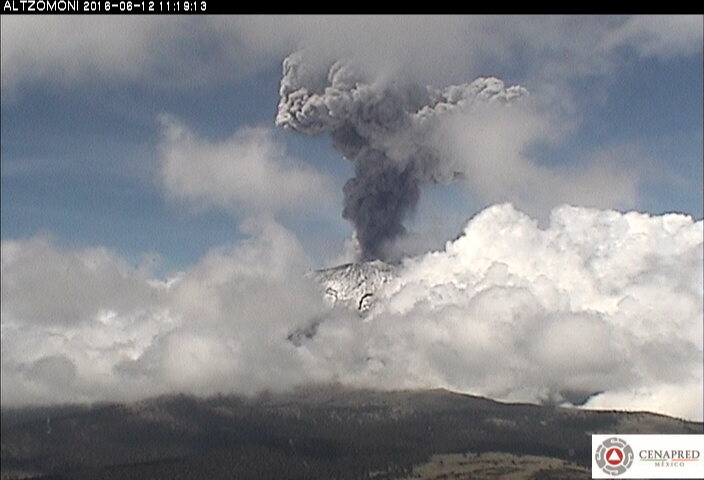Moderately strong eruption of Mexico’s Popocatépetl volcano

A moderately strong eruption was registered at Mexico's Popocatépetl volcano at 16:17 UTC on June 12, 2016. The eruption produced a mushroom-shaped ash cloud that rose up to 2.5 km (8 202 feet) over the crater and dispersed to the west. This is 7.9 km (26 000 feet) above sea level.
Additionally, the volcano recorded 47 low-intensity exhalations with steam and gas emissions over the last 24 hours, CENAPRED reported at 16:45 UTC today.
The agency received only one ash fall report from Ozumba, Estado de México state.
Incandescence and continuous emission of steam and gas were observed during the night.

Popocatépetl volcano erupting on June 12, 2016. Credit: CENAPRED
CENAPRED warns people should not go near the crater, due to the hazard caused by ballistic fragments and the possibility of short-range pyroclastic flows and mudflows.
A 12-km (miles) radius around the crater is closed for visitors.
Population living nearby should be alert for the official information disseminated. In the case of ashfall, cover your nose and mouth with a wet handkerchief or face mask, clean the eyes and throat with pure water, avoid contact lenses to reduce eye irritation, close windows or cover them up, and stay indoors as much as possible.
La explosión 11:17h
Volcán Popocatépetl
Junio 12 desde #Atlixco Puebla, México @Luis_Galeazzi_B & @VicenteLozadaB pic.twitter.com/ZdMZX2U7HC— Geól. Sergio Almazán (@chematierra) June 12, 2016
Geological summary
Volcán Popocatépetl, whose name is the Aztec word for smoking mountain, towers to 5426 m 70 km SE of Mexico City to form North America's 2nd-highest volcano. The glacier-clad stratovolcano contains a steep-walled, 400 x 600 m wide crater. The generally symmetrical volcano is modified by the sharp-peaked Ventorrillo on the NW, a remnant of an earlier volcano. At least three previous major cones were destroyed by gravitational failure during the Pleistocene, producing massive debris-avalanche deposits covering broad areas to the south. The modern volcano was constructed south of the late-Pleistocene to Holocene El Fraile cone.
Three major plinian eruptions, the most recent of which took place about 800 CE, have occurred from Popocatépetl since the mid Holocene, accompanied by pyroclastic flows and voluminous lahars that swept basins below the volcano. Frequent historical eruptions, first recorded in Aztec codices, have occurred since precolumbian time. (GVP)
Feature image: Popocatépetl eruption on June 12, 2016.

Commenting rules and guidelines
We value the thoughts and opinions of our readers and welcome healthy discussions on our website. In order to maintain a respectful and positive community, we ask that all commenters follow these rules:
We reserve the right to remove any comments that violate these rules. By commenting on our website, you agree to abide by these guidelines. Thank you for helping to create a positive and welcoming environment for all.